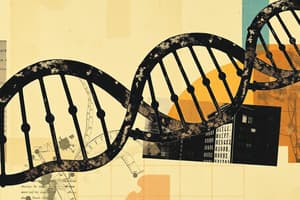Podcast
Questions and Answers
What is the role of DNA as the blueprint for controlling the characteristics of organisms?
What is the role of DNA as the blueprint for controlling the characteristics of organisms?
DNA contains the instructions needed for an organism to grow, develop, survive, and reproduce by controlling protein synthesis.
How are DNA, genes, and chromosomes related?
How are DNA, genes, and chromosomes related?
Genes are segments of DNA that are located on chromosomes, which are structures that contain genetic information.
Where do you get genetic information passed onto offspring?
Where do you get genetic information passed onto offspring?
Genetic information passed onto offspring comes from both parents through meiosis and fertilization.
What pattern of inheritance occurs with the cross Bb x Bb?
What pattern of inheritance occurs with the cross Bb x Bb?
What are the predicted genotypic and phenotypic ratios from a cross involving XBXb x XBY?
What are the predicted genotypic and phenotypic ratios from a cross involving XBXb x XBY?
What is a gene mutation?
What is a gene mutation?
What are the processes involved in natural selection?
What are the processes involved in natural selection?
How is biodiversity a function of evolution?
How is biodiversity a function of evolution?
What is the outcome of natural selection in a population?
What is the outcome of natural selection in a population?
What defines the structure of DNA and its role in inheritance?
What defines the structure of DNA and its role in inheritance?
How do you describe the characteristics of organisms as determined by genes?
How do you describe the characteristics of organisms as determined by genes?
Match the types of cell division with their purposes:
Match the types of cell division with their purposes:
What contributes to genetic variability during meiosis?
What contributes to genetic variability during meiosis?
What is co-dominance and incomplete dominance in inheritance?
What is co-dominance and incomplete dominance in inheritance?
What is the role of X and Y chromosomes in sex determination?
What is the role of X and Y chromosomes in sex determination?
What causes mutations?
What causes mutations?
Define natural selection as a mechanism for evolution.
Define natural selection as a mechanism for evolution.
What distinguishes natural selection from artificial selection?
What distinguishes natural selection from artificial selection?
Evaluate evidence about the evolution of species.
Evaluate evidence about the evolution of species.
What is speciation?
What is speciation?
What role does gene technology play in modern society?
What role does gene technology play in modern society?
Flashcards are hidden until you start studying
Study Notes
Role of DNA
- DNA acts as the blueprint for life, directing growth, development, survival, and reproduction.
- It controls protein synthesis which is essential for cell structure and function.
Relationship: DNA, Genes, and Chromosomes
- DNA is organized into structures called chromosomes; genes are segments of DNA that code for specific proteins.
Genetic Information Inheritance
- Offspring inherit genetic information from both parents through meiosis and fertilization processes.
Patterns of Inheritance
- A dominant (B) and recessive (b) genetic cross (Bb x Bb) can illustrate inheritance patterns.
Offspring Predictions in Genetic Crosses
- In crosses between sex-linked traits (e.g., XBXb x XBY), predict ratios of genotypes and phenotypes based on dominance.
Mutations
- Mutations are permanent changes in the DNA sequence of a gene, potentially leading to functional protein alterations.
- Types of mutations include deletions, duplications, inversions, and translocations.
Natural Selection Processes
- Variation, isolation, and selection drive natural selection.
- Phenotype differences lead to differential survival and reproduction among individuals.
Biodiversity and Evolution
- Biodiversity refers to the variety of life forms within a region and contributes to ecological balance and resilience.
Natural Selection and Artificial Selection
- Investigate how selection pressures, like artificial breeding, can shape population characteristics.
Structure of DNA and Inheritance
- Genetic material is passed from parents to offspring during cell division, ensuring continuity of traits.
Cell Division: Mitosis vs. Meiosis
- Mitosis occurs in body cells for growth, producing two identical diploid daughter cells; meiosis produces four genetically varied haploid sex cells.
Genetic Variability from Meiosis
- Crossing over during prophase I leads to genetic diversity by exchanging segments between homologous chromosomes.
Predicting Genetic Outcomes
- In dominant/recessive crosses (Gg x Gg) or partial inheritance scenarios (RR x WW), predict outcomes based on allele interactions.
Sex Determination and Inheritance
- X and Y chromosomes determine sex; men have XY and women have XX. Both genders can inherit X-linked traits, but only men inherit Y-linked traits.
Mutation Causes and Types
- Mutations can result from environmental factors or errors in DNA replication; they can be deletions, inversions, or translocations.
Natural Selection as Evolution Mechanism
- Natural selection leads to the evolution of species through differential reproduction based on phenotypic variations.
Natural vs. Artificial Selection
- Natural selection occurs through environmental pressures; artificial selection is human-directed breeding for desired traits.
Evidence of Evolution
- Comparative anatomy and embryology reveal common ancestry; fossils illustrate the progression and relationship between extinct and current species.
Speciation Process
- Speciation occurs when groups of individuals are isolated, leading to the evolution of distinct traits and eventual divergence into new species.
Gene Technology Applications
- Gene technology facilitates gene identification and functional understanding, enhancing breeding efficiency and potential future applications in various fields.
Studying That Suits You
Use AI to generate personalized quizzes and flashcards to suit your learning preferences.




